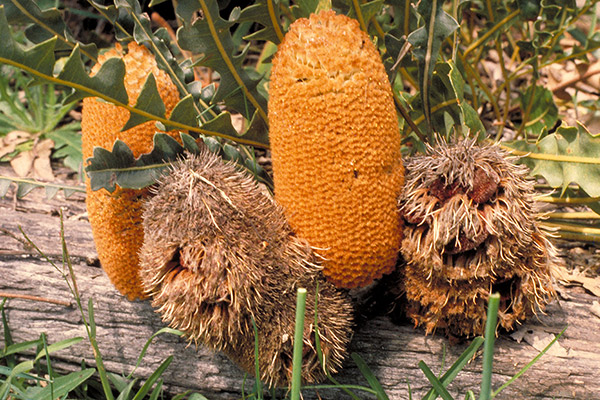
Growing Western Banksias in Containers
Anthony Meyer
Having tried to grow western banksias in the ground in Sydney and having been rewarded with the anticipated disasters, I decided to try growing them in large pots, the big ones which can be bought cheaply in supermarkets. Summarised below are my experiences with this technique over the past 5 years.
Banksias are easy to grow from seed. I use a sterilised seed-raising mix and boiled water to minimise the risk of damping-off, which will often kill young seedlings - I find that fungicides are not particularly useful against this disease. Losses are reduced if the stems of young plants are kept dry when watering and protected from rain until they have a hard, woody outer layer, at about twelve months of age. Good ventilation also helps.
 |
|
Banksia gardneri
Photo: Brian Walters |
|
I have tried various mixes for my banksias from pure furnace ash to sandy mixes and loams. I have found that they will grow and flower in almost any medium - mixes based largely on sand or other very nutrient-poor materials produce much less vigorous plants of poorer appearance. My best results have been with a commercial soil-less potting mix (designed by Neil Black from the Ryde School of Horticulture) which has quite a high content of organic material (pinebark fines). It is very freely draining and is intended for use in situations where frequent watering is involved. I water all my banksias daily in the hotter months and I try never to let the medium dry out completely. This is possible only because I treat all my plants regularly with Fongarid (R) once they are potted on from their sterilised seed-raising mix. I have not lost a plant since I began this treatment five years ago. They are treated monthly in summer (or with soil temperatures over 19oC) and every 6-8 weeks during the rest of the year. Each 50-60 cm pot receives about 1/4 level metric teaspoon of powder in 1-2 litres of water, or proportionately less for smaller pots. This is somewhat above the recommended rate but there have been no problems with toxicity. I found that periods of prolonged rain or high humidity have no detrimental effects on the plants whatsoever with this treatment.
 |
|
Banksia menziesii
Photo: Geoff Clarke |
|
I generally pot seedlings into 15 cm pots and then directly into the largest containers. During the winter dormancy period when many species seem to "switch off" they can be decanted from their pots for tidying of roots and replenishment of potting mix. Incidentally, banksias grown in richer potting media do not seem to produce proteoid roots.
I have also experimented with fertilisers, mainly soluble low-P types. I find that they can be used at full strength without apparent ill-effect although plants grown in nutrient-poor media do not do much better even with heavy fertilising. For most purposes, slow release fertilisers seem to be quite adequate. Most banksias seem to do best in full sun but many of mine have grown and flowered receiving full sun for only part of the day. I do try to protect the pots from heat during the summer.
The only pest of any significance on my Bbanksias has been the borer which destroys flower buds, often even before it is apparent that the bud is forming. The best weapons against these seem to be constant vigilance and a syringe full of methylated spirits. I have noticed recently that a small black spider inhabits the growing tips of many of my banksias and that where there is a spider the flower will form unhindered - a good reason not to use pesticides.
So far I have flowered Banksia victoriae (two seasons), Banksia hookeriana (two seasons), Banksia dryandroides, Banksia burdettii, Banksia menziesii and Banksia gardneri. These all produced flowers at 3-4 years of age from seed. I also have plants of several other species which have not yet produced flowers. If hairy inflorescences such as those of Banksia victoriae got wet once the flowers have opened they often become discoloured, due apparently to mould.
I have yet to try to adapt my methods to growing these plants in the ground but I suspect that some of Peter Olde's ideas for dry country Grevilleas may apply - he recommends a reasonably loamy soil mixed with gravel and raised to assist with drainage. The richer soils are certainly easier to manage than the very sandy ones and the plants seem to thrive in them as long as they can be protected from root diseases.
Banksias as cut flowers do very well in a solution of 2% sugar and 0.1% citric acid with quaternary ammonium disinfectant, as recommended by the late Eric Rymer, often lasting three weeks or more. The individual flowers will even continue to open right to the end of the inflorescence in this mixture.
I have been surprised just how easy it has been to cultivate these magnificent plants in containers and I can thoroughly recommend it as a satisfying way to grow lovely but "difficult" native plants.
From 'Native Plants for New South Wales', the newsletter of the Australian Plants Society (NSW), May/June 1988.
Australian Plants online - 2009
Australian Native Plants Society (Australia)
|